ECO103: Singapore's Macroeconomic Analysis - Growth & Challenges
VerifiedAdded on 2023/06/09
|9
|1827
|406
Report
AI Summary
This report provides a comprehensive macroeconomic analysis of Singapore's economy, focusing on key indicators and current trends. It examines GDP growth, noting a recent slowdown due to contractions in manufacturing and service sectors, exacerbated by US-China trade tensions. The analysis delves into inflation, highlighting the upward trend in both headline and core inflation, driven by demand and cost-push factors. Wage growth is also discussed, raising concerns about lagging productivity and potential unemployment risks. Furthermore, the report explores saving and investment patterns, particularly among millennials, and their impact on capital formation. The report concludes by emphasizing the vulnerability of Singapore's economy to global trade dynamics and the potential for short-term economic fluctuations. Desklib offers similar solved assignments and past papers for students.
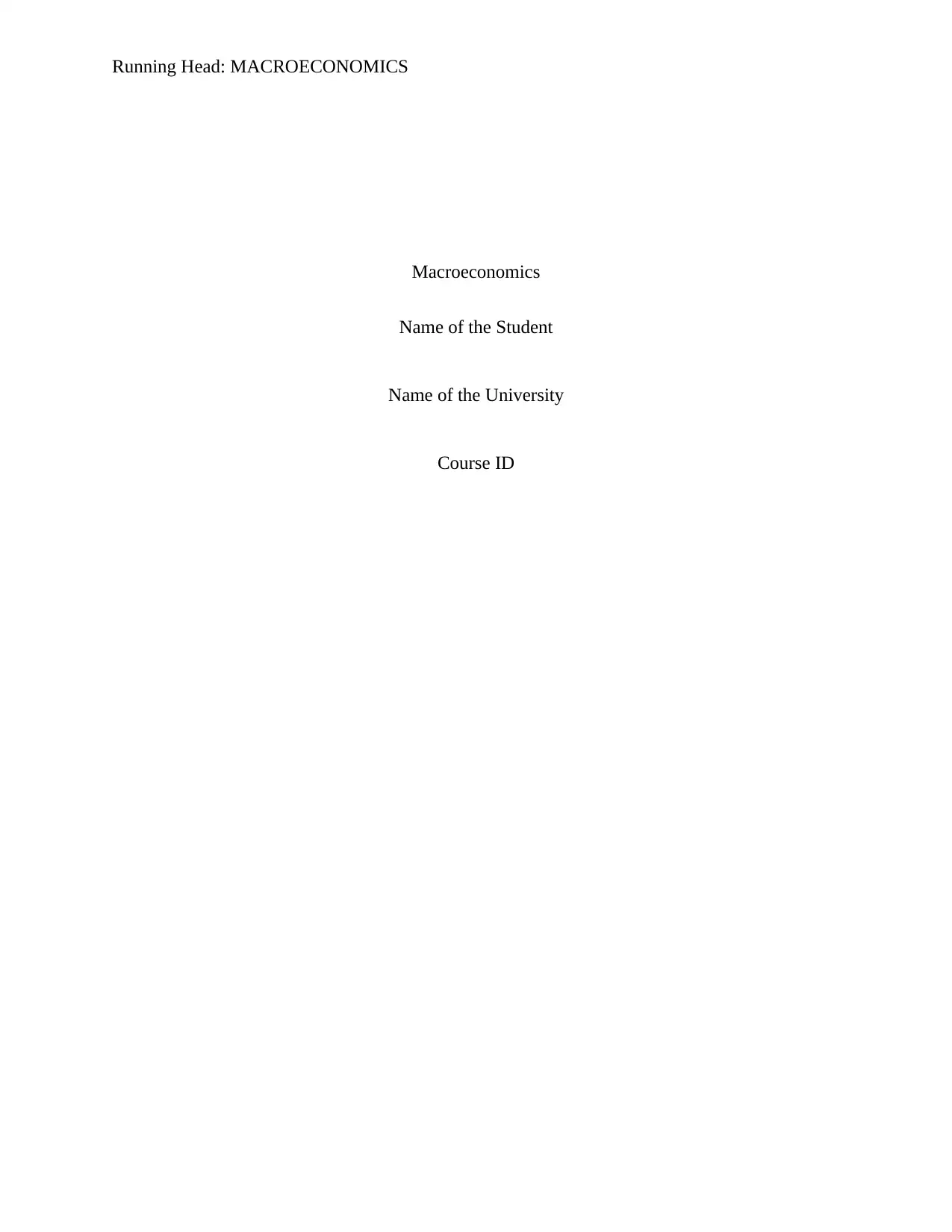
Running Head: MACROECONOMICS
Macroeconomics
Name of the Student
Name of the University
Course ID
Macroeconomics
Name of the Student
Name of the University
Course ID
Paraphrase This Document
Need a fresh take? Get an instant paraphrase of this document with our AI Paraphraser
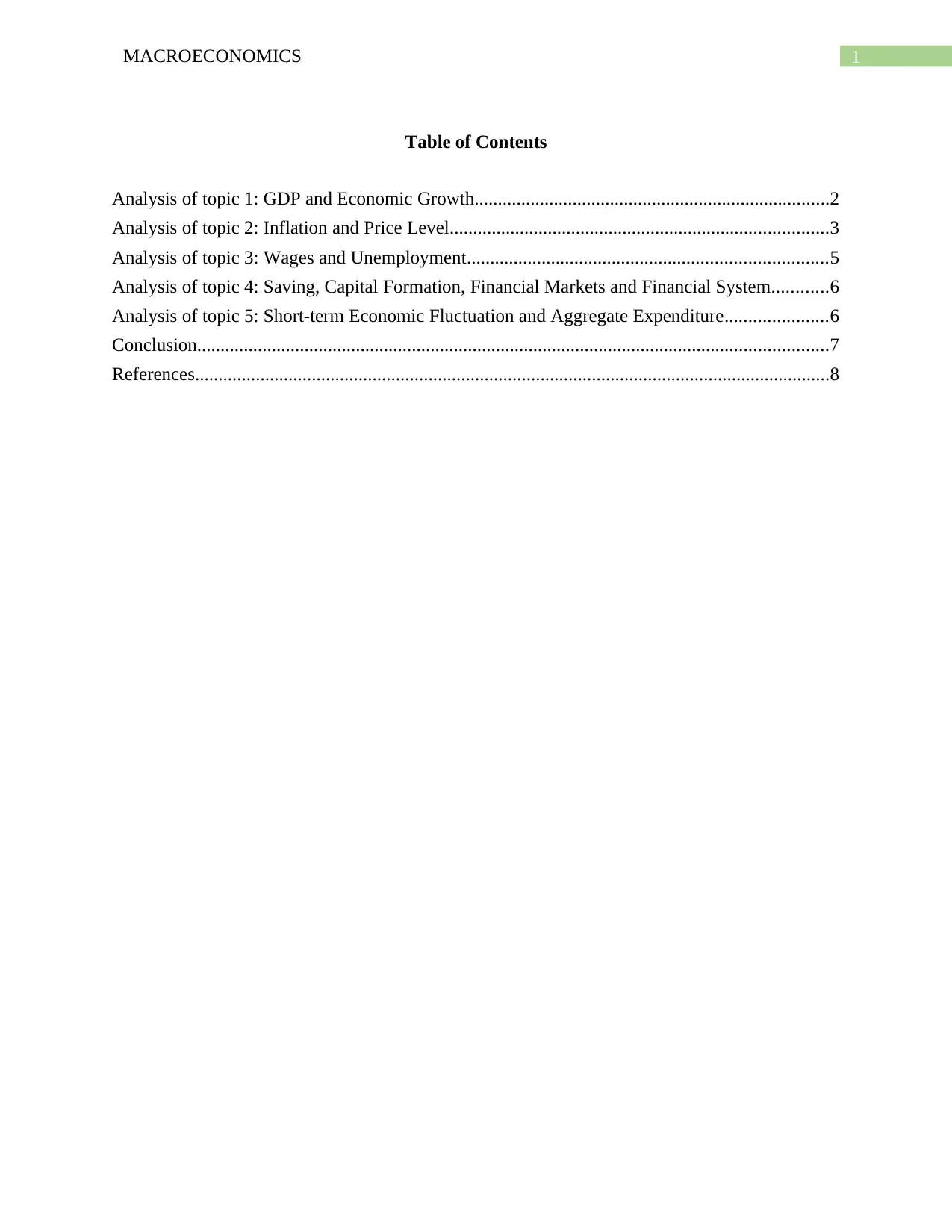
1MACROECONOMICS
Table of Contents
Analysis of topic 1: GDP and Economic Growth............................................................................2
Analysis of topic 2: Inflation and Price Level.................................................................................3
Analysis of topic 3: Wages and Unemployment.............................................................................5
Analysis of topic 4: Saving, Capital Formation, Financial Markets and Financial System............6
Analysis of topic 5: Short-term Economic Fluctuation and Aggregate Expenditure......................6
Conclusion.......................................................................................................................................7
References........................................................................................................................................8
Table of Contents
Analysis of topic 1: GDP and Economic Growth............................................................................2
Analysis of topic 2: Inflation and Price Level.................................................................................3
Analysis of topic 3: Wages and Unemployment.............................................................................5
Analysis of topic 4: Saving, Capital Formation, Financial Markets and Financial System............6
Analysis of topic 5: Short-term Economic Fluctuation and Aggregate Expenditure......................6
Conclusion.......................................................................................................................................7
References........................................................................................................................................8
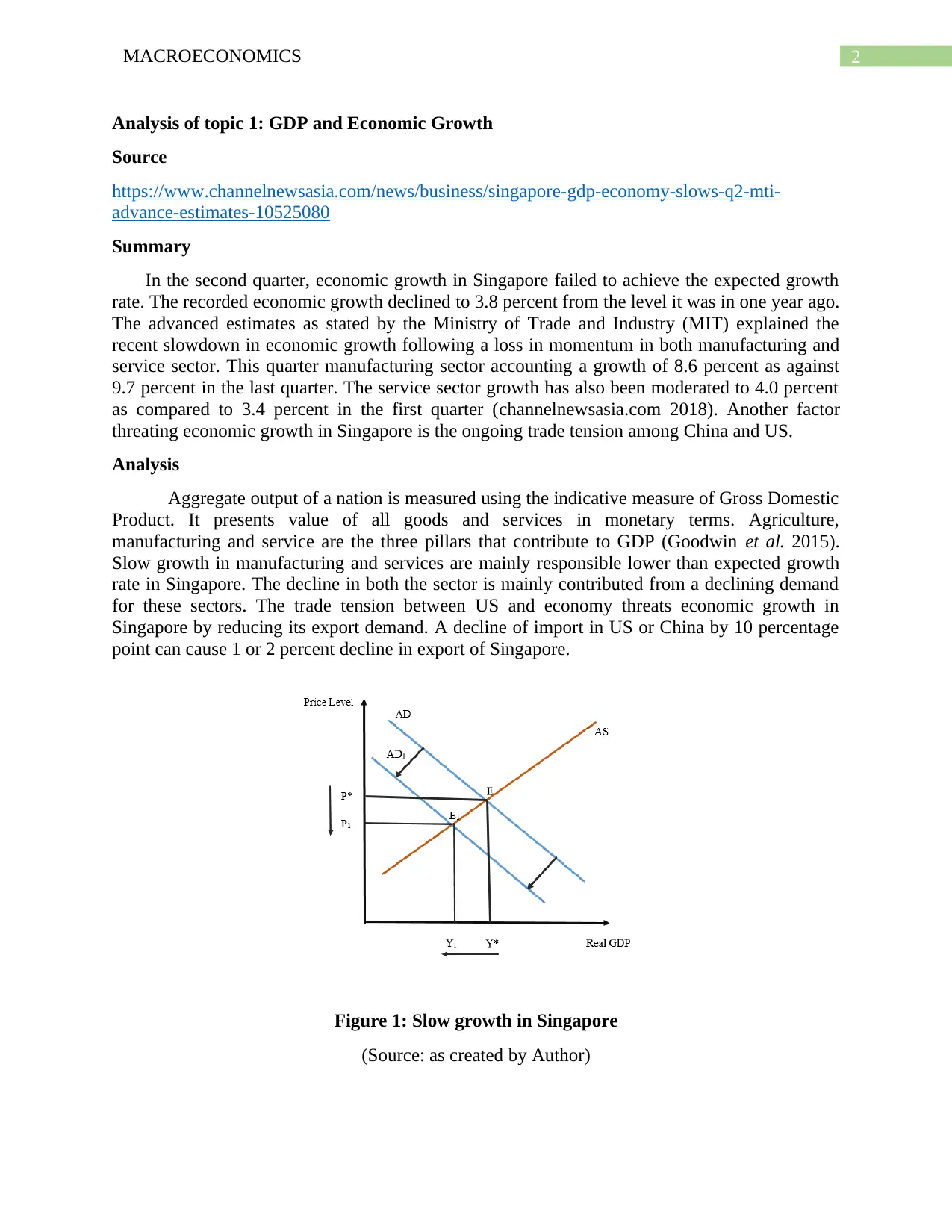
2MACROECONOMICS
Analysis of topic 1: GDP and Economic Growth
Source
https://www.channelnewsasia.com/news/business/singapore-gdp-economy-slows-q2-mti-
advance-estimates-10525080
Summary
In the second quarter, economic growth in Singapore failed to achieve the expected growth
rate. The recorded economic growth declined to 3.8 percent from the level it was in one year ago.
The advanced estimates as stated by the Ministry of Trade and Industry (MIT) explained the
recent slowdown in economic growth following a loss in momentum in both manufacturing and
service sector. This quarter manufacturing sector accounting a growth of 8.6 percent as against
9.7 percent in the last quarter. The service sector growth has also been moderated to 4.0 percent
as compared to 3.4 percent in the first quarter (channelnewsasia.com 2018). Another factor
threating economic growth in Singapore is the ongoing trade tension among China and US.
Analysis
Aggregate output of a nation is measured using the indicative measure of Gross Domestic
Product. It presents value of all goods and services in monetary terms. Agriculture,
manufacturing and service are the three pillars that contribute to GDP (Goodwin et al. 2015).
Slow growth in manufacturing and services are mainly responsible lower than expected growth
rate in Singapore. The decline in both the sector is mainly contributed from a declining demand
for these sectors. The trade tension between US and economy threats economic growth in
Singapore by reducing its export demand. A decline of import in US or China by 10 percentage
point can cause 1 or 2 percent decline in export of Singapore.
Figure 1: Slow growth in Singapore
(Source: as created by Author)
Analysis of topic 1: GDP and Economic Growth
Source
https://www.channelnewsasia.com/news/business/singapore-gdp-economy-slows-q2-mti-
advance-estimates-10525080
Summary
In the second quarter, economic growth in Singapore failed to achieve the expected growth
rate. The recorded economic growth declined to 3.8 percent from the level it was in one year ago.
The advanced estimates as stated by the Ministry of Trade and Industry (MIT) explained the
recent slowdown in economic growth following a loss in momentum in both manufacturing and
service sector. This quarter manufacturing sector accounting a growth of 8.6 percent as against
9.7 percent in the last quarter. The service sector growth has also been moderated to 4.0 percent
as compared to 3.4 percent in the first quarter (channelnewsasia.com 2018). Another factor
threating economic growth in Singapore is the ongoing trade tension among China and US.
Analysis
Aggregate output of a nation is measured using the indicative measure of Gross Domestic
Product. It presents value of all goods and services in monetary terms. Agriculture,
manufacturing and service are the three pillars that contribute to GDP (Goodwin et al. 2015).
Slow growth in manufacturing and services are mainly responsible lower than expected growth
rate in Singapore. The decline in both the sector is mainly contributed from a declining demand
for these sectors. The trade tension between US and economy threats economic growth in
Singapore by reducing its export demand. A decline of import in US or China by 10 percentage
point can cause 1 or 2 percent decline in export of Singapore.
Figure 1: Slow growth in Singapore
(Source: as created by Author)
⊘ This is a preview!⊘
Do you want full access?
Subscribe today to unlock all pages.

Trusted by 1+ million students worldwide

3MACROECONOMICS
Analysis of topic 2: Inflation and Price Level
Source
https://www.businesstimes.com.sg/government-economy/singapores-inflation-up-in-may-in-line-
with-economists-expectations
Summary
Headline inflation in Singapore increased in May giving expectation of further increase
over the year. The Consumer Price Index rose to 0.4 percent as compared to 0.1 percent in the
month of April. Core inflation increased at an even faster rate with CPI grew by 1.5 percent year
on year basis from an increase of 1.3 percent in the previous month. The rise in both core and
headline inflation caused by increase in prices of all major categories of CPI basket excluding
food (businesstimes.com.sg 2018). Headline inflation picked up mainly due to an increase
transportation cost. Service inflation and retail price also increases in the same time.
Analysis
Inflation is the phenomenon of a gradual rise in the overall level of price. In Singapore
both headline and core inflation are going at a faster pace. The core inflation measures exclude
cost of road transport and accommodation. The development of trend consumer price is given in
the figure below
Figure 2: Consumer Price development
(Source: businesstimes.com.sg 2018)
Analysis of topic 2: Inflation and Price Level
Source
https://www.businesstimes.com.sg/government-economy/singapores-inflation-up-in-may-in-line-
with-economists-expectations
Summary
Headline inflation in Singapore increased in May giving expectation of further increase
over the year. The Consumer Price Index rose to 0.4 percent as compared to 0.1 percent in the
month of April. Core inflation increased at an even faster rate with CPI grew by 1.5 percent year
on year basis from an increase of 1.3 percent in the previous month. The rise in both core and
headline inflation caused by increase in prices of all major categories of CPI basket excluding
food (businesstimes.com.sg 2018). Headline inflation picked up mainly due to an increase
transportation cost. Service inflation and retail price also increases in the same time.
Analysis
Inflation is the phenomenon of a gradual rise in the overall level of price. In Singapore
both headline and core inflation are going at a faster pace. The core inflation measures exclude
cost of road transport and accommodation. The development of trend consumer price is given in
the figure below
Figure 2: Consumer Price development
(Source: businesstimes.com.sg 2018)
Paraphrase This Document
Need a fresh take? Get an instant paraphrase of this document with our AI Paraphraser
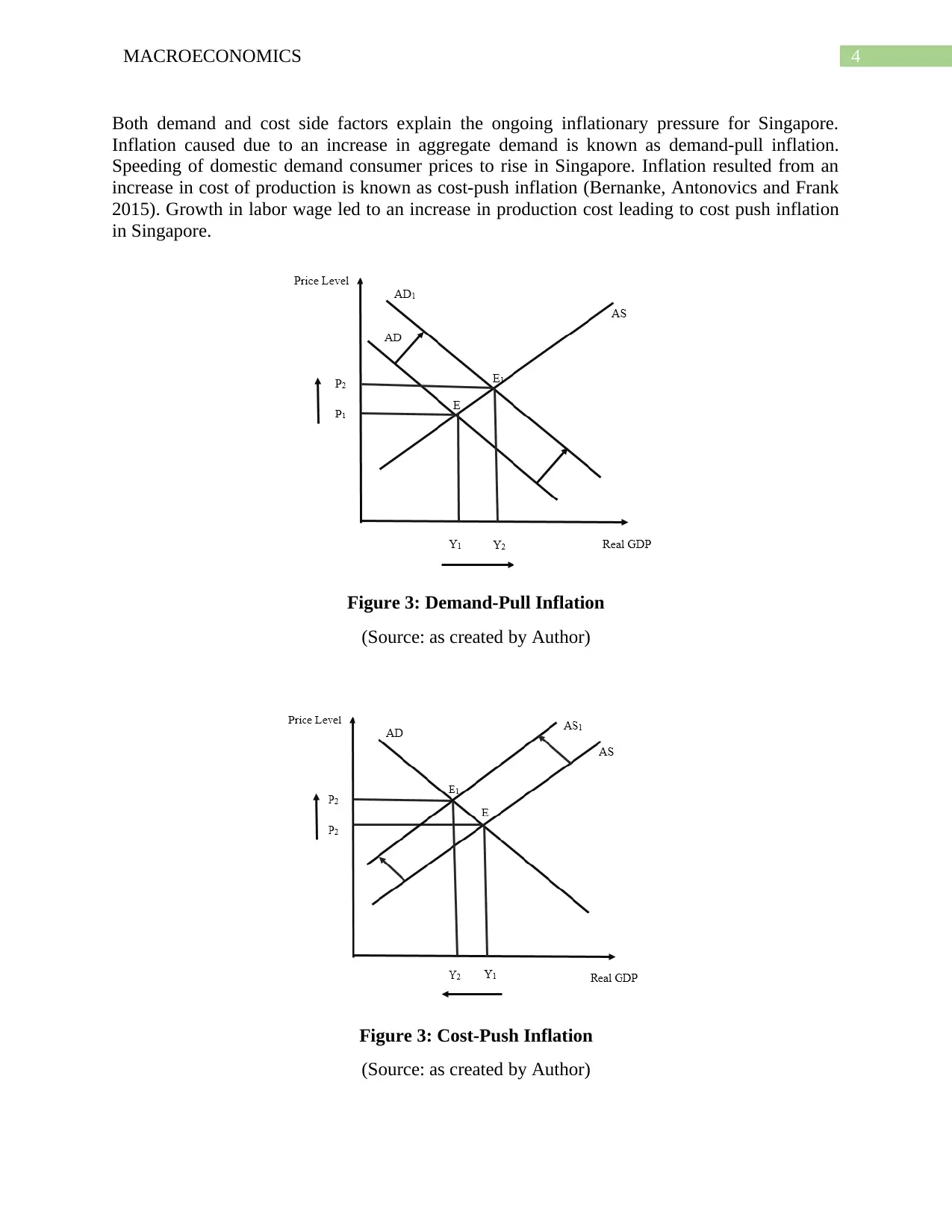
4MACROECONOMICS
Both demand and cost side factors explain the ongoing inflationary pressure for Singapore.
Inflation caused due to an increase in aggregate demand is known as demand-pull inflation.
Speeding of domestic demand consumer prices to rise in Singapore. Inflation resulted from an
increase in cost of production is known as cost-push inflation (Bernanke, Antonovics and Frank
2015). Growth in labor wage led to an increase in production cost leading to cost push inflation
in Singapore.
Figure 3: Demand-Pull Inflation
(Source: as created by Author)
Figure 3: Cost-Push Inflation
(Source: as created by Author)
Both demand and cost side factors explain the ongoing inflationary pressure for Singapore.
Inflation caused due to an increase in aggregate demand is known as demand-pull inflation.
Speeding of domestic demand consumer prices to rise in Singapore. Inflation resulted from an
increase in cost of production is known as cost-push inflation (Bernanke, Antonovics and Frank
2015). Growth in labor wage led to an increase in production cost leading to cost push inflation
in Singapore.
Figure 3: Demand-Pull Inflation
(Source: as created by Author)
Figure 3: Cost-Push Inflation
(Source: as created by Author)
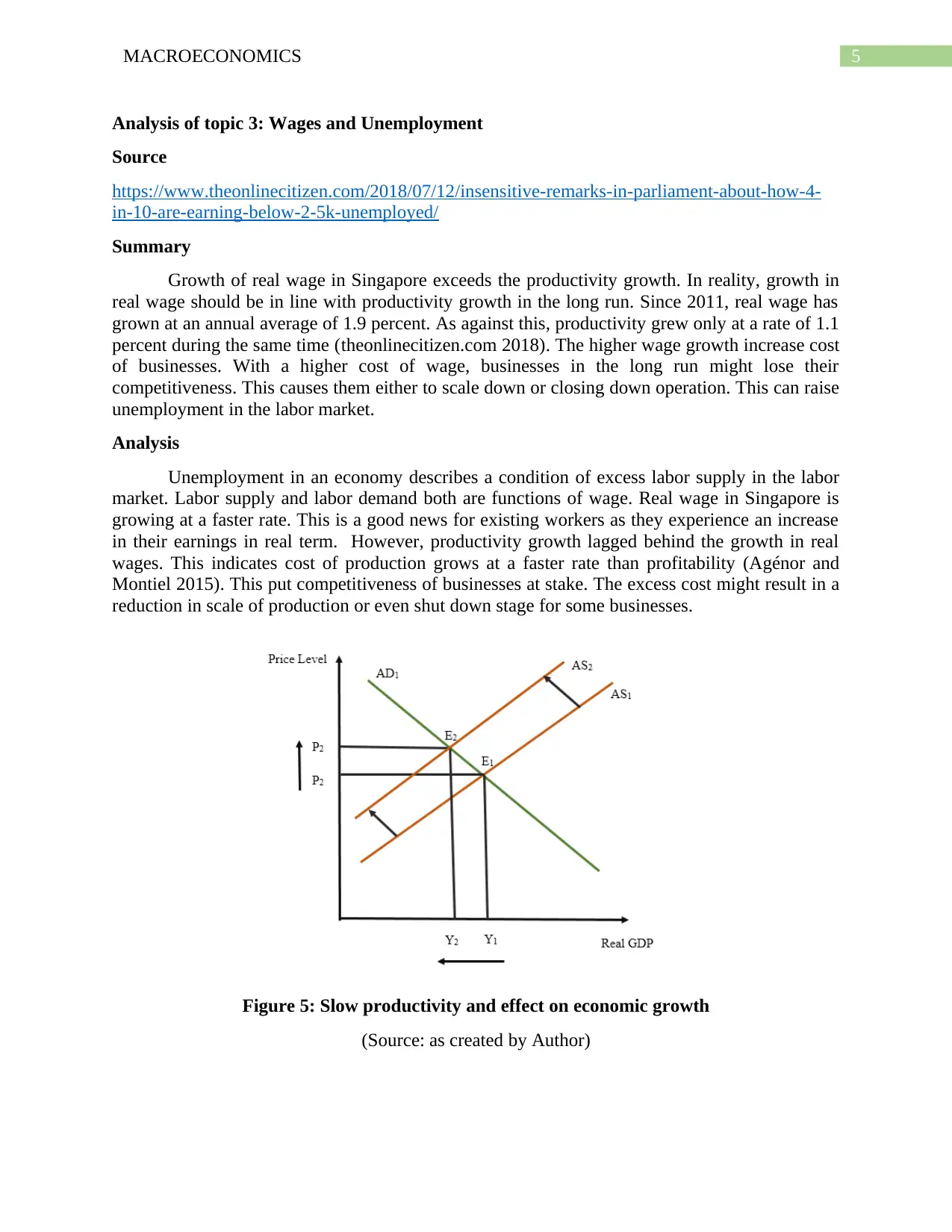
5MACROECONOMICS
Analysis of topic 3: Wages and Unemployment
Source
https://www.theonlinecitizen.com/2018/07/12/insensitive-remarks-in-parliament-about-how-4-
in-10-are-earning-below-2-5k-unemployed/
Summary
Growth of real wage in Singapore exceeds the productivity growth. In reality, growth in
real wage should be in line with productivity growth in the long run. Since 2011, real wage has
grown at an annual average of 1.9 percent. As against this, productivity grew only at a rate of 1.1
percent during the same time (theonlinecitizen.com 2018). The higher wage growth increase cost
of businesses. With a higher cost of wage, businesses in the long run might lose their
competitiveness. This causes them either to scale down or closing down operation. This can raise
unemployment in the labor market.
Analysis
Unemployment in an economy describes a condition of excess labor supply in the labor
market. Labor supply and labor demand both are functions of wage. Real wage in Singapore is
growing at a faster rate. This is a good news for existing workers as they experience an increase
in their earnings in real term. However, productivity growth lagged behind the growth in real
wages. This indicates cost of production grows at a faster rate than profitability (Agénor and
Montiel 2015). This put competitiveness of businesses at stake. The excess cost might result in a
reduction in scale of production or even shut down stage for some businesses.
Figure 5: Slow productivity and effect on economic growth
(Source: as created by Author)
Analysis of topic 3: Wages and Unemployment
Source
https://www.theonlinecitizen.com/2018/07/12/insensitive-remarks-in-parliament-about-how-4-
in-10-are-earning-below-2-5k-unemployed/
Summary
Growth of real wage in Singapore exceeds the productivity growth. In reality, growth in
real wage should be in line with productivity growth in the long run. Since 2011, real wage has
grown at an annual average of 1.9 percent. As against this, productivity grew only at a rate of 1.1
percent during the same time (theonlinecitizen.com 2018). The higher wage growth increase cost
of businesses. With a higher cost of wage, businesses in the long run might lose their
competitiveness. This causes them either to scale down or closing down operation. This can raise
unemployment in the labor market.
Analysis
Unemployment in an economy describes a condition of excess labor supply in the labor
market. Labor supply and labor demand both are functions of wage. Real wage in Singapore is
growing at a faster rate. This is a good news for existing workers as they experience an increase
in their earnings in real term. However, productivity growth lagged behind the growth in real
wages. This indicates cost of production grows at a faster rate than profitability (Agénor and
Montiel 2015). This put competitiveness of businesses at stake. The excess cost might result in a
reduction in scale of production or even shut down stage for some businesses.
Figure 5: Slow productivity and effect on economic growth
(Source: as created by Author)
⊘ This is a preview!⊘
Do you want full access?
Subscribe today to unlock all pages.

Trusted by 1+ million students worldwide
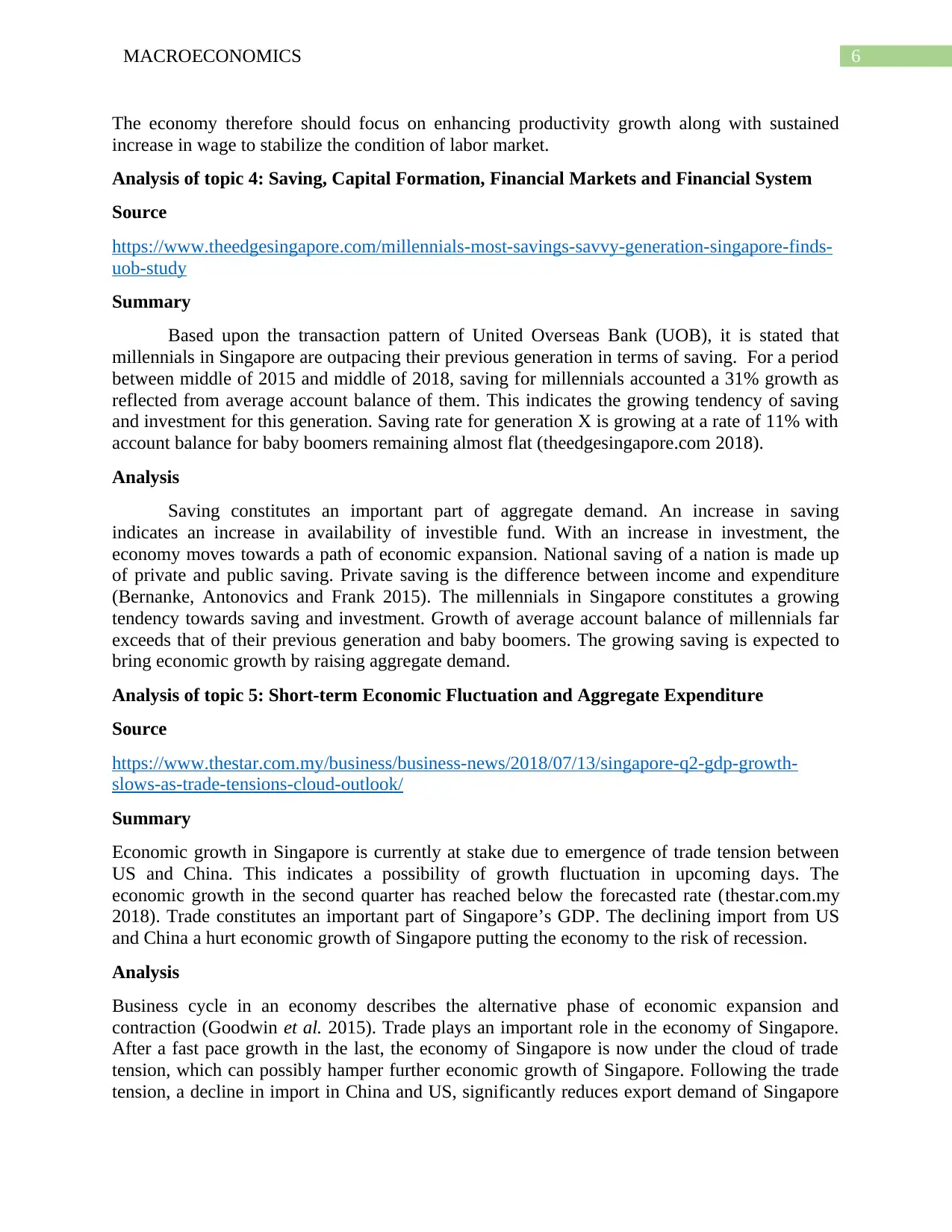
6MACROECONOMICS
The economy therefore should focus on enhancing productivity growth along with sustained
increase in wage to stabilize the condition of labor market.
Analysis of topic 4: Saving, Capital Formation, Financial Markets and Financial System
Source
https://www.theedgesingapore.com/millennials-most-savings-savvy-generation-singapore-finds-
uob-study
Summary
Based upon the transaction pattern of United Overseas Bank (UOB), it is stated that
millennials in Singapore are outpacing their previous generation in terms of saving. For a period
between middle of 2015 and middle of 2018, saving for millennials accounted a 31% growth as
reflected from average account balance of them. This indicates the growing tendency of saving
and investment for this generation. Saving rate for generation X is growing at a rate of 11% with
account balance for baby boomers remaining almost flat (theedgesingapore.com 2018).
Analysis
Saving constitutes an important part of aggregate demand. An increase in saving
indicates an increase in availability of investible fund. With an increase in investment, the
economy moves towards a path of economic expansion. National saving of a nation is made up
of private and public saving. Private saving is the difference between income and expenditure
(Bernanke, Antonovics and Frank 2015). The millennials in Singapore constitutes a growing
tendency towards saving and investment. Growth of average account balance of millennials far
exceeds that of their previous generation and baby boomers. The growing saving is expected to
bring economic growth by raising aggregate demand.
Analysis of topic 5: Short-term Economic Fluctuation and Aggregate Expenditure
Source
https://www.thestar.com.my/business/business-news/2018/07/13/singapore-q2-gdp-growth-
slows-as-trade-tensions-cloud-outlook/
Summary
Economic growth in Singapore is currently at stake due to emergence of trade tension between
US and China. This indicates a possibility of growth fluctuation in upcoming days. The
economic growth in the second quarter has reached below the forecasted rate (thestar.com.my
2018). Trade constitutes an important part of Singapore’s GDP. The declining import from US
and China a hurt economic growth of Singapore putting the economy to the risk of recession.
Analysis
Business cycle in an economy describes the alternative phase of economic expansion and
contraction (Goodwin et al. 2015). Trade plays an important role in the economy of Singapore.
After a fast pace growth in the last, the economy of Singapore is now under the cloud of trade
tension, which can possibly hamper further economic growth of Singapore. Following the trade
tension, a decline in import in China and US, significantly reduces export demand of Singapore
The economy therefore should focus on enhancing productivity growth along with sustained
increase in wage to stabilize the condition of labor market.
Analysis of topic 4: Saving, Capital Formation, Financial Markets and Financial System
Source
https://www.theedgesingapore.com/millennials-most-savings-savvy-generation-singapore-finds-
uob-study
Summary
Based upon the transaction pattern of United Overseas Bank (UOB), it is stated that
millennials in Singapore are outpacing their previous generation in terms of saving. For a period
between middle of 2015 and middle of 2018, saving for millennials accounted a 31% growth as
reflected from average account balance of them. This indicates the growing tendency of saving
and investment for this generation. Saving rate for generation X is growing at a rate of 11% with
account balance for baby boomers remaining almost flat (theedgesingapore.com 2018).
Analysis
Saving constitutes an important part of aggregate demand. An increase in saving
indicates an increase in availability of investible fund. With an increase in investment, the
economy moves towards a path of economic expansion. National saving of a nation is made up
of private and public saving. Private saving is the difference between income and expenditure
(Bernanke, Antonovics and Frank 2015). The millennials in Singapore constitutes a growing
tendency towards saving and investment. Growth of average account balance of millennials far
exceeds that of their previous generation and baby boomers. The growing saving is expected to
bring economic growth by raising aggregate demand.
Analysis of topic 5: Short-term Economic Fluctuation and Aggregate Expenditure
Source
https://www.thestar.com.my/business/business-news/2018/07/13/singapore-q2-gdp-growth-
slows-as-trade-tensions-cloud-outlook/
Summary
Economic growth in Singapore is currently at stake due to emergence of trade tension between
US and China. This indicates a possibility of growth fluctuation in upcoming days. The
economic growth in the second quarter has reached below the forecasted rate (thestar.com.my
2018). Trade constitutes an important part of Singapore’s GDP. The declining import from US
and China a hurt economic growth of Singapore putting the economy to the risk of recession.
Analysis
Business cycle in an economy describes the alternative phase of economic expansion and
contraction (Goodwin et al. 2015). Trade plays an important role in the economy of Singapore.
After a fast pace growth in the last, the economy of Singapore is now under the cloud of trade
tension, which can possibly hamper further economic growth of Singapore. Following the trade
tension, a decline in import in China and US, significantly reduces export demand of Singapore
Paraphrase This Document
Need a fresh take? Get an instant paraphrase of this document with our AI Paraphraser
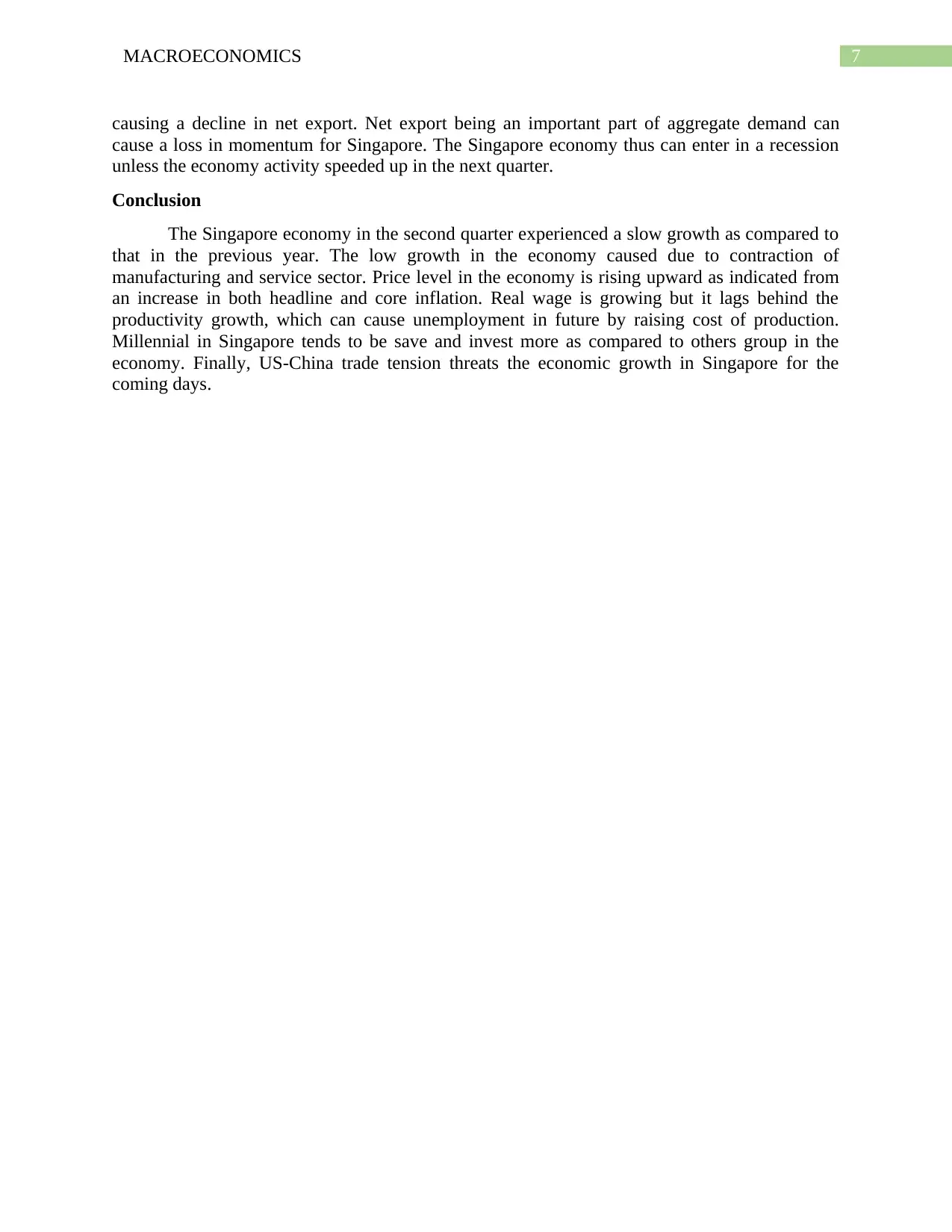
7MACROECONOMICS
causing a decline in net export. Net export being an important part of aggregate demand can
cause a loss in momentum for Singapore. The Singapore economy thus can enter in a recession
unless the economy activity speeded up in the next quarter.
Conclusion
The Singapore economy in the second quarter experienced a slow growth as compared to
that in the previous year. The low growth in the economy caused due to contraction of
manufacturing and service sector. Price level in the economy is rising upward as indicated from
an increase in both headline and core inflation. Real wage is growing but it lags behind the
productivity growth, which can cause unemployment in future by raising cost of production.
Millennial in Singapore tends to be save and invest more as compared to others group in the
economy. Finally, US-China trade tension threats the economic growth in Singapore for the
coming days.
causing a decline in net export. Net export being an important part of aggregate demand can
cause a loss in momentum for Singapore. The Singapore economy thus can enter in a recession
unless the economy activity speeded up in the next quarter.
Conclusion
The Singapore economy in the second quarter experienced a slow growth as compared to
that in the previous year. The low growth in the economy caused due to contraction of
manufacturing and service sector. Price level in the economy is rising upward as indicated from
an increase in both headline and core inflation. Real wage is growing but it lags behind the
productivity growth, which can cause unemployment in future by raising cost of production.
Millennial in Singapore tends to be save and invest more as compared to others group in the
economy. Finally, US-China trade tension threats the economic growth in Singapore for the
coming days.
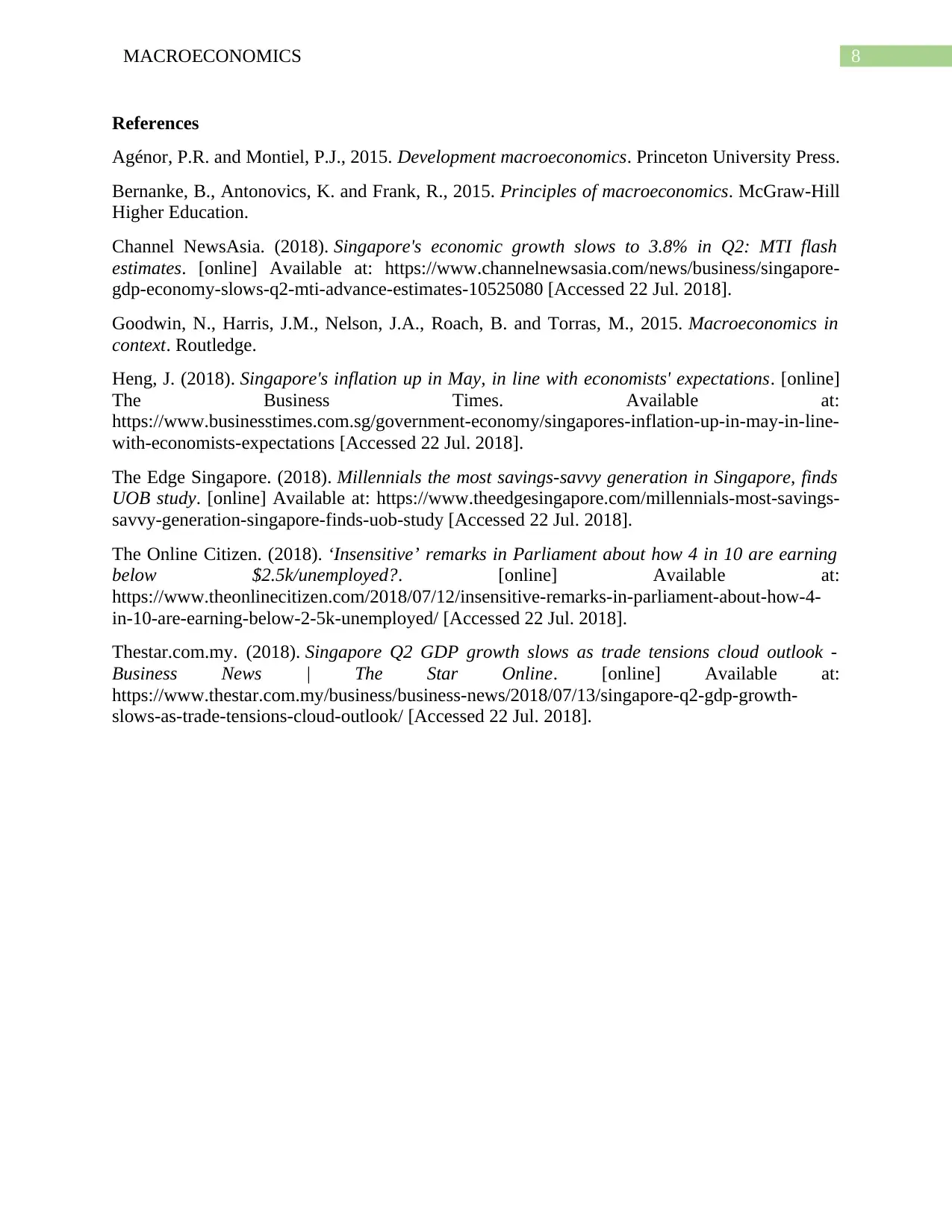
8MACROECONOMICS
References
Agénor, P.R. and Montiel, P.J., 2015. Development macroeconomics. Princeton University Press.
Bernanke, B., Antonovics, K. and Frank, R., 2015. Principles of macroeconomics. McGraw-Hill
Higher Education.
Channel NewsAsia. (2018). Singapore's economic growth slows to 3.8% in Q2: MTI flash
estimates. [online] Available at: https://www.channelnewsasia.com/news/business/singapore-
gdp-economy-slows-q2-mti-advance-estimates-10525080 [Accessed 22 Jul. 2018].
Goodwin, N., Harris, J.M., Nelson, J.A., Roach, B. and Torras, M., 2015. Macroeconomics in
context. Routledge.
Heng, J. (2018). Singapore's inflation up in May, in line with economists' expectations. [online]
The Business Times. Available at:
https://www.businesstimes.com.sg/government-economy/singapores-inflation-up-in-may-in-line-
with-economists-expectations [Accessed 22 Jul. 2018].
The Edge Singapore. (2018). Millennials the most savings-savvy generation in Singapore, finds
UOB study. [online] Available at: https://www.theedgesingapore.com/millennials-most-savings-
savvy-generation-singapore-finds-uob-study [Accessed 22 Jul. 2018].
The Online Citizen. (2018). ‘Insensitive’ remarks in Parliament about how 4 in 10 are earning
below $2.5k/unemployed?. [online] Available at:
https://www.theonlinecitizen.com/2018/07/12/insensitive-remarks-in-parliament-about-how-4-
in-10-are-earning-below-2-5k-unemployed/ [Accessed 22 Jul. 2018].
Thestar.com.my. (2018). Singapore Q2 GDP growth slows as trade tensions cloud outlook -
Business News | The Star Online. [online] Available at:
https://www.thestar.com.my/business/business-news/2018/07/13/singapore-q2-gdp-growth-
slows-as-trade-tensions-cloud-outlook/ [Accessed 22 Jul. 2018].
References
Agénor, P.R. and Montiel, P.J., 2015. Development macroeconomics. Princeton University Press.
Bernanke, B., Antonovics, K. and Frank, R., 2015. Principles of macroeconomics. McGraw-Hill
Higher Education.
Channel NewsAsia. (2018). Singapore's economic growth slows to 3.8% in Q2: MTI flash
estimates. [online] Available at: https://www.channelnewsasia.com/news/business/singapore-
gdp-economy-slows-q2-mti-advance-estimates-10525080 [Accessed 22 Jul. 2018].
Goodwin, N., Harris, J.M., Nelson, J.A., Roach, B. and Torras, M., 2015. Macroeconomics in
context. Routledge.
Heng, J. (2018). Singapore's inflation up in May, in line with economists' expectations. [online]
The Business Times. Available at:
https://www.businesstimes.com.sg/government-economy/singapores-inflation-up-in-may-in-line-
with-economists-expectations [Accessed 22 Jul. 2018].
The Edge Singapore. (2018). Millennials the most savings-savvy generation in Singapore, finds
UOB study. [online] Available at: https://www.theedgesingapore.com/millennials-most-savings-
savvy-generation-singapore-finds-uob-study [Accessed 22 Jul. 2018].
The Online Citizen. (2018). ‘Insensitive’ remarks in Parliament about how 4 in 10 are earning
below $2.5k/unemployed?. [online] Available at:
https://www.theonlinecitizen.com/2018/07/12/insensitive-remarks-in-parliament-about-how-4-
in-10-are-earning-below-2-5k-unemployed/ [Accessed 22 Jul. 2018].
Thestar.com.my. (2018). Singapore Q2 GDP growth slows as trade tensions cloud outlook -
Business News | The Star Online. [online] Available at:
https://www.thestar.com.my/business/business-news/2018/07/13/singapore-q2-gdp-growth-
slows-as-trade-tensions-cloud-outlook/ [Accessed 22 Jul. 2018].
⊘ This is a preview!⊘
Do you want full access?
Subscribe today to unlock all pages.

Trusted by 1+ million students worldwide
1 out of 9
Related Documents
Your All-in-One AI-Powered Toolkit for Academic Success.
+13062052269
info@desklib.com
Available 24*7 on WhatsApp / Email
![[object Object]](/_next/static/media/star-bottom.7253800d.svg)
Unlock your academic potential
Copyright © 2020–2025 A2Z Services. All Rights Reserved. Developed and managed by ZUCOL.



